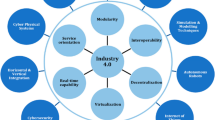Abstract
The rising demand for individualised products is one of the most important trends in today’s market. This is having a big impact on the manufacturing industry since it means that the flexibility of production machines must be increased. Packaging machines are greatly affected by the rising demand for format-flexibility because of decreasing batch sizes, the high number of format changes and the resulting lack of productivity. In the past, packaging machines as well as other production machines were developed with a focus on large-scale production. Hence, offering format-flexible packaging machines is a new challenge for manufacturers. Improvements in format-flexibility have to take place within the development process of the manufacture of packaging machines. This paper presents an overall concept which integrates four design modules into a generalised development process. These four design modules support developers in creating a solution regarding format flexibility which is, from a technical and economic point of view optimised for the demands of the users of packaging machines. The approach is focused on the special requirements of packaging machines, but it can be adapted for other types of production machines.









Similar content being viewed by others
References
Neugebauer R (2012) Werkzeugmaschinen. Springer Vieweg, Berlin
Rudolf H (2006) Wissensbasierte Montageplanung in der Digitalen Fabrik am Beispiel der Automobilindustrie. Herbert Utz, München
Jäger S (2004) Absatzsysteme für Mass Customization. Deutscher Universitäts-Verlag, München
Roland Berger (2012) Mastering product complexity 2012. http://www.rolandberger.us/media/pdf/Roland_Berger_Mastering-Product-Complexity_20121107
Jonas K (2005) Packaging Machinery and Equipment. U.S. Commercial Service Germany
Dumoulin E (2012) Changes and perspectives in food studies. Int J Food Stud IJFS 1:211–221
Römisch P, Weiß M (2014) Projektierungspraxis Verarbeitungsanlagen. Springer Vieweg, Wiesbaden
Sethi A, Sethi S (1990) Flexibility in manufacturing: a survey. Int J Flexible Manuf Syst 2:289–328
Wiendahl H-P, ElMaraghy HA, Nyhuis P, Zäh MF, Wiendahl H–H, Duffie N, Brieke M (2007) Changeable manufacturing—classification, design and operation. Ann CIRP 56/2:783–809
Abele E, Liebeck T, Wörn A (2006) measuring flexibility in investment decisions for manufacturing systems. Ann CIRP 55/1:433–436
Slack N (1983) Flexibility as a manufacturing objective. Int J Operat Prod Manag 3:4–13
Zäh M, Möller N, Vogl W (2005) Symbiosis of Changeable and Virtual Production. CARV 05 International Conference on Changeable, Agile, Reconfigurable and Virtual Production, pp. 3–10
Wiendahl H-P (2009) Veränderungsfähigkeit von Produktionsunternehmen - Ein morphologischer Ansatz. ZWF 104:32–37
Bleisch G, Langowski H-C, Majschak J-P (2014) Lexikon Verpackungstechnik. B. Behr’s, Hamburg
Shingo S (1985) A Revolution in manufacturing: the SMED system. Productivity Press, Cambridge
McIntosh R, Culley S, Mileham A, Owen G (2001) Improving Changeover Performance. Butterworth-Heinemann, Oxford
Sekine K, Arai K (1992) Kaizen for quick changeover—going beyond SMED. Productivity Press, Cambridge
Mileham A, Culley S, Owen G, McIntosh R (1999) Rapid changeover—pre-requisite for responsive manufacture. Int J Operations Prod Manag 19:785–796
Van Gouberger D, van Landeghem H (2002) Rules for integrating fast changeover capabilities into new equipment design. Robot Comput Integrated Manuf 18:205–214
Reik M, McIntosh R, Culley S, Mileham A, Owen G (2006) A formal design for changeover methodology. Part 1: theory and background. J Eng Manuf 220:1225–1235
Reik M, McIntosh R, Culley S, Mileham A, Owen G (2006) A formal design for changeover methodology. Part 2: methodology and case study. J Eng Manuf 220:1237–1247
Owen G, Matthews J, McIntosh R, Culley S (2011) Design for changeover (DFC): enabling flexible and highly responsive manufacturing. In: Fogliatto F, da Silveira G (2011) Mass customization. Springer, London
VDI-Gesellschaft (1993) VDI 2221: Systematic approach to the development and design of technical systems and products. Beuth, Berlin
VDI-Gesellschaft (2004) VDI 2206: Design methodology for mechatronic systems. Beuth, Berlin
Götz G, Rohrhirsch M, Gebbe C, Richter C, Reinhart G (2017) Economical comparison of packaging machines: a new approach based on an economic evaluation model. Appl Mech Mater 856:109–116
Gausemeier J, Fink A, Schlake O (1998) Scenario management. Technol Forecast Soc Chang 59:111–130
Gausemeier J, Plass C (2014) Zukunftsorientierte Unternehmensgestaltung. Carl Hanser, München, p 48
Schack R (2008) Methodik zur bewertungsorientierten Skalierung der Digitalen Fabrik. Utz, München, p 126
Götze M (2008) Investitionsrechnung. Springer, Berlin, p 375
Klemke T (2014) Planung der systemischen Wandlungsfähigkeit von Fabriken. TEWISS, Garbsen, p 67
Götz G, Stich P, Backhaus J, Reinhart G (2016) Design Approach for the Development of Format-Flexible Packaging Machines. International Conference on Mechatronics and Computational Mechanics 2016, Singapore
Schuh G, Klappert S (2011) Technologiemanagement. Springer, Berlin, p 230
Götz G, Fink J, Richter C, Reinhart G (2016) Increasing the format-flexibility of packaging machines: experimental study on laser beam sealing and cutting. Appl Mech Mater 856:201–208
Götz G, Stich P, Thunig S, Glasschröder J, Reinhart G (2015) Improving resource and energy efficiency of packaging machines: contribution of an increasing format flexibility. Appl Mech Mater 805:257–264
Acknowledgements
The authors would like to thank the Bavarian Ministry of Economic Affairs and Media, Energy and Technology for the funding of the project Green Factory Bavaria within the program “Zukunftsinitiative Aufbruch Bayern”.
Author information
Authors and Affiliations
Corresponding author
Rights and permissions
About this article
Cite this article
Götz, G., Kiefer, L., Richter, C. et al. A design approach for the development of flexible production machines. Prod. Eng. Res. Devel. 12, 331–340 (2018). https://doi.org/10.1007/s11740-018-0804-5
Received:
Accepted:
Published:
Issue Date:
DOI: https://doi.org/10.1007/s11740-018-0804-5




